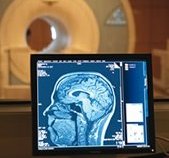Autobiographical Memory and Amnesia
Autobiographical remembering comprises multiple interacting mental activities. Much of our research emphasizes the distinction between two elements of autobiographical memory: semantic and episodic. Semantic autobiographical memory concerns historical facts, traits, and knowledge states that are not linked to a specific time and place. Episodic autobiographical memory concerns recollection of specific events, accompanied by a state of consciousness that marks the experience as part of one's own personal history. Evidence suggests that these two forms of autobiographical memory may be processed by separate brain systems. Our research has examined this dissociation in neuropsychological patients and in healthy adults using functional brain imaging (fMRI).Neuropsychological Patients
One line of evidence comes from patients with amnesia restricted to either episodic or semantic autobiographical memory. Patient M.L. has isolated retrograde amnesia, a rare syndrome in which memories prior to the brain injury are lost yet new learning and memory are preserved (Levine et al., 1998). M.L. was able to relearn semantic autobiographical memory, although his experience of this knowledge was in the third-person. He remained unable to access episodic autobiographical memory. Studies on patient M.L. have been important in understanding the neuroanatomical and psychological correlates of episodic autobiographical amnesia. For more on our investigations of patient M.L., click here.We have argued that impaired episodic autobiographical memory in patients with brain disease is more common than is currently recognized. This problem is in part due to a lack of psychometric technology for assessing autobiographical memory. In collaboration with Morris Moscovitch, we have developed the Autobiographical Interview, which provides separate indices of episodic and semantic memory from within a single autobiographical recollection using text-based analysis of the transcribed protocol. Our initial study with this instrument (Levine, Svoboda et al., 2002) indicated distinct styles of autobiographical memory in younger and older adults (see also St-Jacques & Levine, 2007). We have also used this instrument to explore temporal gradients of episodic and semantic autobiographical memory loss in patients with semantic dementia (McKinnon et al., 2006) and in amnesic patients, including patient H.M. (Steinvorth et al., 2005; Rosenbaum et al., 2004; Rosenbaum et al., 2008; see also Addis et al. 2007, Brain, 130, 2327-42 for epilepsy). In patients with frontotemporal lobar degeneration (also known as frontotemporal degeneration [FTD] of Pick's disease), a common form of pre-senile dementia, we demonstrated specific impairment in episodic, but not semantic autobiogrpahical memory both cross-sectionally and longitudinally (McKinnon et al., 2008). Using our structural neuroimage analysis protcols, we were able to localize this impairment to a left-lateralized network centered on the medial temporal lobe. Taken together, these studies have demonstrated specific impairment in lifespan episodic (but not semantic) autobiographical memory in association with medial temporal lobe damage.
Functional Neuroimaging
Functional neuroimaging allows us to examine the neuroanatomical correlates of mental activity in healthy adults. Since the early 1990's, memory researchers studied the functional neuroanatomy of various mnemonic processes using laboratory tasks. Far fewer imaging studies have employed more naturalistic autobiographical memory tasks. These tasks typically require use self-generated autobiographical memories harvested before the scanning session or during the scan itself. For a recent meta-analytic review of this literature, see Svoboda et al. (2006).In order to avoid the confounds inherent to self-generated autobiographical material, we developed a prospective "diary" method in which participants document unique episodes from their daily life using an audio recorder (Levine et al, 2004). Recordings are then selected from this pool for exposure during scanning, much the same way words might be drawn from a pool in a traditional laboratory memory study, providing a level of control over autobiographical stimuli unattainable with self-generated memories. In our first study using this method, we found distinct patterns of brain activation associated with hearing recordings documenting a specific episode from one's personal past versus personal semantic information (i.e., repeated events or states of being).
This method allowed us to investigate the effects of rehearsal on episodic and semantic autobiographical memory (Svoboda & Levine, 2009). Rehearsal effects are inherent to distinctions between memory conditions, such as that between old and new autobiographical memories. Yet it is impossible to disentangle rehearsal effects from factors such as age, vividness, and emotional significance using naturalistic autobiographical stimuli. We controlled for these factors by randomly assigning recorded episodic autobiographical and semantic stimuli to different rehearsal conditions. We found that even a single rehearsal exposure induced a dramatic repetition suppression effect in the autobiographical memory network. Nonetheless, there was a distinction in brain activation patterns between episodic and semantic stimuli even after eight repetitions. This effect included the hippocampus, which was specifically engaged by the episodic autobiographical stimuli over and above semantic stimuli. This finding was interpreted as supporting Multiple Trace Theory, which states that the hippocampus is engaged by episodically rich representations in spite of the passage of time or amount of reactivations.
